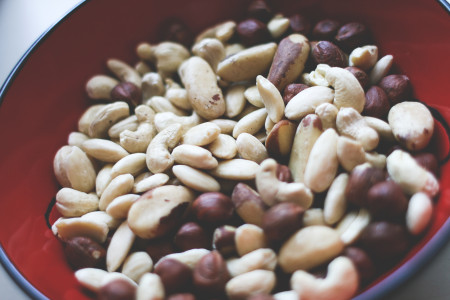12 Kitchen Staples for Healthy Eating in a Crunch
I’m freaking busy… in a totally awesome, but still crazy kinda way. So, cooking complex, extravagant meals just isn’t in the cards for me.
I’m guessing it’s not in the cards for you, too?
The good news is that eating healthy, flavorful, delicious meals doesn’t have to be complicated. I get by with very little in my kitchen (a necessity with my apartment size fridge and freezer and lack of cabinetry). Here’s the 12 things I absolutely can’t live without in my kitchen (and some quick healthy eating tips on how I use them!).
1. Himalayan Sea Salt
Not all salt is created equal! Himalayan sea salt is the most natural form of salt available and has 84 minerals that your body needs that you just don’t get in table salt.
2. Healthy Oils
I always have coconut and extra virgin olive oil on hand – I use coconut oil for any high heat cooking and EVOO to dress cooked veggies or for salads… but my new OBSESSION is avocado oil. It is super mild in flavor so I find it way more versatile than coconut oil, which can unintentionally leave dishes feeling “Thai-inspired”.
3. Dijon Mustard
I used to laugh at the Grey Poupon commercial growing up… “Excuse me, do you have any Grey Poupon?” It was absurd and ridiculous. Well, now that’s me. I slather this stuff on EVERYTHING: fish, veggie burgers, shrimp, and I’ve even mixed it into egg and tuna salad for a little kick. Best part: it’s a totally guilt free indulgence!
4. Shakeology
My secret weapon! After just 4 days of adding Shakeology to my diet, I said goodbye to my daily afternoon 3 pm crash forever. Packed with 70 superfoods, antioxidants, prebiotics, probiotics, and adaptogens, Shakeology is the perfect addition to my morning smoothie.
5. Frozen Burger Patties (turkey, salmon, and veggie)
These are a LIFESAVER. The best part: no defrosting required. Just throw them on the stove frozen and they’ll cook up just fine. I buy all three in bulk from Costco to save time and money – plus, I legit eat burger patties (no bun!) 2-3 nights a week, so I need them in quantity.
6. Eggs
I love eggs! I eat 2 scrambled eggs for lunch several times a week. Eggs are so versatile, they’re easy to keep fresh – I mix them with kimchi, any number of veggies, tomato sauce, horseradish, you name it!
7. Quinoa
Quinoa is super simple to make and can be dressed up or down based on your preference. I usually throw in a tablespoon of coconut oil to enrich the nutty flavor and stir in some veggies to create some variety in the texture. Check out my 1 pot quinoa dinner here.
8. Pre-Washed Organic Greens (mixed or spinach)
There’s nothing simpler than these – I use them as a base for salads, for sautéing (spinach only) and in my morning smoothies. To keep them fresh longer, check out this quick tip:
9. Frozen Organic Steam-in-Bag Veggies
These are a GODSEND. Plain, pre-chopped, pre-cleaned veggies that I can cook without dirtying a dish in 6 minutes flat? Yes, please! If you’re worried about the plastic, please know that “these are special bags specifically designed for microwave cooking. They are 100% microwave oven safe and are specially designed from plastics meeting FDA regulations and do not contain PVC, Phthalate, BPA, PFOA or melamine”. (Source: Birds Eye Foods) And, of course, if you’re weary of the bags, don’t use them, but DON’T SKIP YOUR VEGGIES, either!
10. Mixed, Unsalted Nuts
These are my favorite grab and go snack! And did you know, a handful of nuts a day has been linked to a longer life. Century club here I come!
11. Sweet potatoes
When I’m craving something sweet but want to avoid snacking, sweet potatoes are the perfect fix. I pop them in the microwave and top with peanut butter, pumpkin pie spice, or a sprinkling of blue cheese and walnuts.
12. Seltzer
I love water, but it can get plain-old boring sometimes. Lately, I’ve been obsessed with adding seltzer to the mix and I’ve recently been experimenting with some fun mocktails. My fav so far? Cucumber and dill!
That’s my must-have list. What’s on yours?



